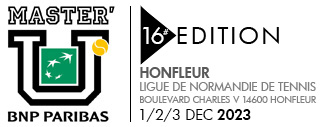The realization of a rope lasts about twenty minutes. Here in time-lapse, the racket of the French player Julien Eon, “rather versatile but rather driven power. ”
This is an understatement: without his racket, the tennis player is nothing. And a tennis racket is more complicated than it seems. Decryption with Flavien Flament and Thibaut Faure, stringers during the Master’U BNP Paribas.
A crucial choice: “The racket is 50% of a player’s performance. For a competitor, you have to know how to play on different levers: the rope, the string layout, the grammage of the racket, its profile … ”
The sieve: “This is the frame of the racket. There are sieves of different sizes: small, medium and large. The smaller the sieve, the harder it will be to center the ball. But if we succeed, we will have more precision. With a wider sieve, we lose precision but we will gain power. For the pros, it will be more sieve means, as here at Master’U BNP Paribas. ”
The profile: “It’s the width of the frame of the racket. We have rather narrow profiles, others larger ones. Narrow profiles are the most difficult to handle. Large profiles are used by older, quieter people. ”
The grammage: “It’s the weight of the racket. The more we increase it, the more difficult it will be to control it. With a heavy racket, we gain in power but we tire more quickly. Conversely, with a light racket, we lose power, but we gain control and maneuverability. The pros use heavy rackets.
The natural gut string: “It’s the best in terms of comfort. But it’s at the expense of the shelf life. It is a very fragile rope. ”
The synthetic rope in multi-filaments: “Always very flexible and very comfortable. ”
Synthetic rope in monofilament: “The rope is for the competitors. With less comfort, but a lot more spin and speed. From a certain level, third or second series, everyone plays in mono-filament. Here at Master’U BNP Paribas, all players are equipped with this type of rope. ”
The shape of the rope: “The more round it is, the more it is used by those who favor power. The square string is for the hook: the ball will stay longer in the racket and the player will have more control. And then we have the octagonal shape: there it will be more for taking effects. ”
The tension of the rope: “At most we will tend, the more the ball will return in the field, it will get closer to the net. The more the rope is relaxed, the longer the ball will go. The tension depends on the style of play. There is no standard and there is everything at Master’U BNP Paribas. ”
Gauge: “It’s the thickness of rope. The more we go up gauge, so in thickness, more rope will have a significant life but will lose touch. Great competitors have weak gauges. On the other hand, it breaks faster. It is for this reason that players change a lot of rackets. ”
The number of rackets: “It depends. There are some who have five / six rackets and will spin. If they face a puncher who sends mines all-out, they will tend a little more to keep the ball on the ground. They try to adapt according to the player in front and have several rackets with different tensions to adapt to that. After, each player has his style. Federer adapts his racket for all that is going to be power of flat game and big debauchery of energy at the level of the striking. Nadal him, he is more octagonal shape for the taking effect. And then there are some who have their fetish racket: it’s psychological. And as soon as it breaks, it will be necessary that immediately the first is recorded to leave with »
Interviewed by Kévin Saroul
Video directed by Antoine Decarne



